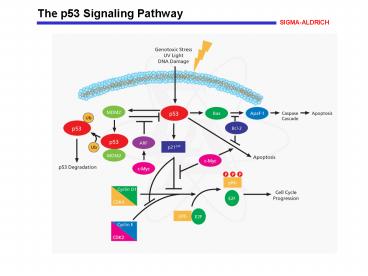The p53 Signaling Pathway - PowerPoint PPT Presentation
1 / 2
Title:
The p53 Signaling Pathway
Description:
The tumor-suppressor protein p53 exhibits sequence-specific DNA-binding, ... Jimenez, G.S., et al., p53 regulation by post-translational modification and ... – PowerPoint PPT presentation
Number of Views:735
Avg rating:3.0/5.0
Title: The p53 Signaling Pathway
1
The p53 Signaling Pathway
SIGMA-ALDRICH
2
The p53 Signaling Pathway The tumor-suppressor
protein p53 exhibits sequence-specific
DNA-binding, directly interacts with various
cellular and viral proteins, and induces cell
cycle arrest in response to DNA damage. In
response to signals generated by a variety of
genotoxic stresses, e.g, UV irradiation or DNA
damage, p53 is expressed and undergoes
post-translational modification that results in
its accumulation in the nucleus. The
p53-dependent pathways help to maintain genomic
stability by eliminating damaged cells, either by
arresting them permanently or through apoptosis.
For example, ?-irradiation activates p53 to turn
on the transcription of p21CIP1, that, in turn,
binds to and inhibits cyclin-dependent kinases,
causing hypophosphorylation of retinoblastoma
(Rb), thus preventing the release of E2F and
blocking the G1-S transition. Some of the
cellular effects of p53 can be blocked by the
deregulated expression of c-Myc, Bcl-2, or E2F.
p53 activity is controlled through an
autoregulatory loop involving Mdm2. The binding
of Mdm2 to p53 targets p53 for degradation and
inhibits p53-induced cell-cycle arrest and
apoptosis. References Gu, J., et al.,
Identification of a sequence element from p53
that signals for Mdm2-targeted degradation. Mol.
Cell Biol., 20, 1243-1253 (2000). Jimenez, G.S.,
et al., p53 regulation by post-translational
modification and nuclear retention in response to
diverse stresses. Oncogene, 18, 7656-7665
(1999). King, K.L., and Cidlowski, J.A., Cell
cycle regulation and apoptosis. Annu. Rev.
Physiol., 60, 601-617 (1998).































